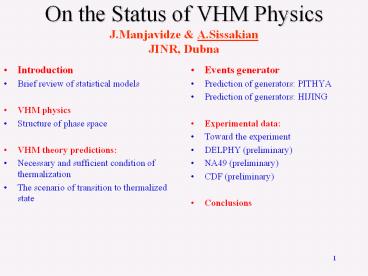On the Status of VHM Physics J.Manjavidze - PowerPoint PPT Presentation
Title:
On the Status of VHM Physics J.Manjavidze
Description:
... hep-ph/00110221; hep-ph/0206203; P.Braun-Munzinger, et al., nucl-th/9903010; U. ... A661 (1999) 140c; P.Braun-Munzinger, et al., hep-ph/0105229; H.Oeschler, ... – PowerPoint PPT presentation
Number of Views:10
Avg rating:3.0/5.0
Title: On the Status of VHM Physics J.Manjavidze
1
On the Status of VHM PhysicsJ.Manjavidze
A.Sissakian JINR, Dubna
- Introduction
- Brief review of statistical models
- VHM physics
- Structure of phase space
- VHM theory predictions
- Necessary and sufficient condition of
thermalization - The scenario of transition to thermalized state
- Events generator
- Prediction of generators PITHYA
- Prediction of generators HIJING
- Experimental data
- Toward the experiment
- DELPHY (preliminary)
- NA49 (preliminary)
- CDF (preliminary)
- Conclusions
2
Phenomenology indications of statistics brief
review of statistical models (1999 - 2003)
- Theoretical background
- Schwinger Keldysh (1964) Niemi Semenoff
(1984) Carruthers Zachariazen (1986), ...
- The statistical thermal model is in good
agreement with experimental data of heavy ion
collisions - F.Becattini, et al, hep-ph/0002267hep-ph/00
110221 hep-ph/0206203 P.Braun-Munzinger, et
al., nucl-th/9903010 U.Heinz P.F.Kolb,
hep-ph/0204061 ... - The improved statistical model shows that the
chemical equilibrium is reached in heavy ion
collisions - U.Henz, Nucl.Phys., A661 (1999) 140c
P.Braun-Munzinger, et al., hep-ph/0105229
H.Oeschler, - nucl-ex/0011007 Zhong-Dao Lu,
hep-ph/0207029 R.Baier et al., hep-ph/0204211 - Statistical methods in multiple production
- J.B.Elliot et al., Phys. Rev. Lett., 85
(2000) 1194 C.Tsallis, Lect. Notes in Phys. LNP
560 (2000), G.A.Kozlov, New J. Phys., 4 (2002)
23 D.Kharzeev, hep-ph/0204015 E.Shuryak,
hep-ph/0205031 I.M.Dremin V.A.Nechitailo,
hep-ph/0207068 L.Gutay et al., E-735 Coll.
(FNAL), ISMD-02 - A.Sissakian, Nucl.Phys. (in press, 2003),
J.Manjavidze, VHMp Proc. (2003), N.Shubutidze,
Proc. XI Lomonosov Conf. (2003) ...
3
The structure of phase space
- Regge - soft hadron dynamics
(V.Gribov, K.Ter-Martirosyan, A.Kaidalov,
P.Landshof, BFKL, ... ) - DIS - hard hadron dynamics
(DGLAP,...) - VHM - hard low-x hadron dynamics
(L.Gribov et al., L.Lipatov,
J.Manjavidze A.Sissakian,...)
- Symmetry constrains are not important outside
Regge domain - LLA ideology can not be used outside DIS
domain - Strong coupling tQCD was built to describe the
VHM domain
(J.Manjavidze A.Sissakian, Theor. Math. Phys.
130 (2002) 153)
4
Necessary and sufficient condition of
thermalization
- One can prove if the inequality
-
- is hold, then the thermalization occurs.
- J.Manjavidze A.Sissakian, Phys. Rep., 346
(2001) 1
The central energy correlation functions
Averaging is performed over the semi-exclusive
cross sections
is the n-particle amplitude
5
The scenario of transition to thermalized state
- - mutiperipheral
kinematics region - - hard (multi)-jet kinematics
- - LLA kinematics threshold
- VHM -- region of thermalization
- C - limiting thermalization region produced
particle momentum,
6
Prediction of generators PYTHYA
- A. One may conclude that the dynamical models
built into the PYTHIA can not predict
thermalization. - B. The transition region to thermalized state.
VHM may belong to it. - C. The limiting thermalization region
- Yu.Kulchitski et al.
7
Prediction of generators HIJING
- The tendency to equilibrium is interpreted as a
result of rescattering. - The heavy ion collisions may be a preferable to
observe thermalization phenomenon.
- V. Uzhinsky et al.
8
PYTHIA
- The ratio
- Red line
- M.Gostkin et al.
9
Toward the experiment
To observe thermalization it is necessary to
investigate inequality
()
- If the inequality () is hold then
is the chemical potential, is the temperature.
10
DELPHY (preliminary)
M.Nikolenko, A.Olshevski at al.
11
NA49 (preliminary)
- G.Melkumov, N.Agababian, et al.
12
NA49 (preliminary)
- G.Melkumov, N.Agababian, et al.
13
CDF (preliminary)
J.Budagov, Yu.Kulchitski, N.Moggi, F.Rimondi, et
al.
14
Conclusions
- NICE
- Ordinary (Regge, pQCD in LLA,) theoretical
models can not predict
even the tendency to equilibrium - Our S-matrix interpretation of thermodynamics
shows that the thermalization must occur, at
least, in a deep asymptotics over multiplicity. - Impact of the approach is it possible to use the
thermodynamics in hadron collisions?
- The fact that we have a multiparticle system is
not enough to justify the use - of the thermodynamics
- The method that makes it possible to find the
necessary and sufficient - conditions for a thermodynamic description to be
valid.































